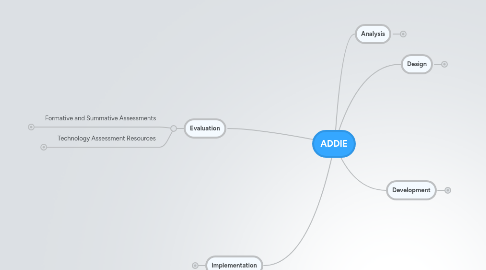
1. Implementation
1.1. Teaching Channel Teacher Help
1.2. Strategies for Time Management
1.3. Procedures and Efficiency
1.4. Getting their attention
2. Evaluation
2.1. Formative and Summative Assessments
2.1.1. Writing and Evaluating Questionnaires
2.1.2. Writing and Evaluating Summative Assessments
2.1.3. Choice-based Assessments
2.1.4. Checkpoints of learning = Formative
2.1.5. Final Mastery Assessment = Summative
2.2. Technology Assessment Resources
2.2.1. SMART Response
2.2.2. Turning Point
2.2.3. Google Forms
2.2.4. Socrative
3. Analysis
3.1. Learner Analysis
3.1.1. Relevant learner characteristics
3.1.1.1. Age
3.1.1.2. Interests
3.1.1.3. Demographics
3.1.1.4. Socio-economic status
3.1.1.5. Funds of Knowledge
3.1.1.6. Learning styles
3.1.1.7. Culture
3.1.1.8. Special needs
3.1.1.9. Cognitive and Affective Development
3.1.1.10. Favorite subjects
3.1.1.11. Background knowledge
3.2. Context Analysis
3.2.1. School community
3.2.2. Textbooks/curriculum materials
3.2.3. Classroom space
3.2.4. Number of students
3.2.5. Colleagues
3.2.6. Geographic surroundings
3.2.7. specialists
3.3. Content Analysis
3.3.1. Self-assessment of content knowledge
3.3.2. Standards
3.3.3. Internet research
3.3.4. District/State requirements
3.3.5. Available materials
3.3.6. Activities
4. Design
4.1. Create objectives
4.1.1. ABCD Model
4.1.1.1. Audience
4.1.1.1.1. SWBAT
4.1.1.1.2. Intended audience
4.1.1.2. Behavior
4.1.1.2.1. Cognitive
4.1.1.2.2. Affective
4.1.1.2.3. Bloom's Taxonomy
4.1.1.2.4. Psychomotor
4.1.1.2.5. Interpersonal
4.1.1.3. Condition
4.1.1.3.1. Equipment/tools used
4.1.1.3.2. What is a condition of learning?
4.1.1.4. Degree
4.1.1.4.1. Standard for performance
4.1.1.4.2. To what degree?
4.1.2. Terminal Objectives
4.1.2.1. What students will know/ be able to do at the end of the lesson
4.1.3. Enabling Objectives
4.1.3.1. Knowledge and skills that enable learner to reach the Terminal Objective
4.1.4. Essential Questions
4.1.4.1. Subjective
4.1.4.2. Why and How?
4.1.4.3. Broad concepts
4.1.5. Enduring Understandings
4.1.5.1. Two concepts explored to create a relationship
4.1.5.2. No proper nouns/ personal pronouns
4.1.5.3. No past/past perfect/ present perfect tenses
4.2. Sequencing
4.3. UbD
4.3.1. Unit Design Template
4.3.2. Lesson Plan Template
4.3.3. Principles of Backward Design
4.3.4. Essential Questions! (Curriculum Mapping). Enduring Understandings
4.4. UDL
4.4.1. Overview
4.4.2. Assistive Technology
4.4.3. Differentiation
4.4.3.1. Content
4.4.3.2. Process
4.4.3.3. Product
4.4.4. Worksheet
4.4.4.1. Interactive Wheel
4.4.5. Resource from Hopkins
5. Development
5.1. Gagne' 9 Events
5.1.1. Graphic
5.2. SMCM Lesson Planning Template
5.3. Create Assessments
5.4. Prepare and Understand Technology
5.5. Implementation Plan
5.6. Differentiation
5.6.1. Look at students needs and adjust instruction accordingly
5.6.2. Content
5.6.3. Process
5.6.4. Product
5.6.5. Environment
5.6.6. Assistive Technology
5.6.7. IEP

